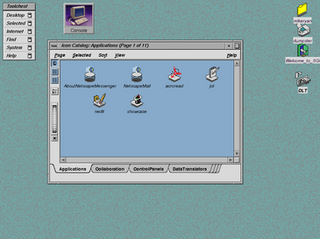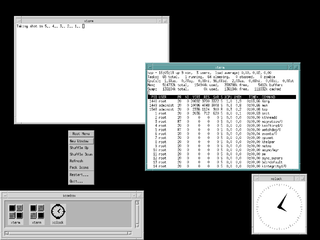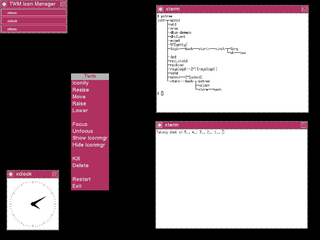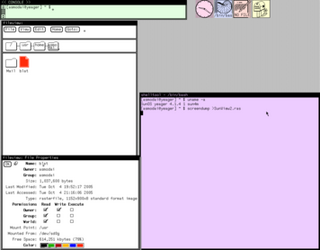
The Common Desktop Environment (CDE) is a desktop environment for Unix and OpenVMS, based on the Motif widget toolkit. It was part of the UNIX 98 Workstation Product Standard, and was for a long time the Unix desktop associated with commercial Unix workstations. It helped to influence early implementations of successor projects such as KDE and GNOME, which largely replaced CDE following the turn of the century.

The history of the graphical user interface, understood as the use of graphic icons and a pointing device to control a computer, covers a five-decade span of incremental refinements, built on some constant core principles. Several vendors have created their own windowing systems based on independent code, but with basic elements in common that define the WIMP "window, icon, menu and pointing device" paradigm.

IRIX is a discontinued operating system developed by Silicon Graphics (SGI) to run on the company's proprietary MIPS workstations and servers. It is based on UNIX System V with BSD extensions. In IRIX, SGI originated the XFS file system and the industry-standard OpenGL graphics system.

Silicon Graphics, Inc. was an American high-performance computing manufacturer, producing computer hardware and software. Founded in Mountain View, California in November 1981 by James Clark, its initial market was 3D graphics computer workstations, but its products, strategies and market positions developed significantly over time.

The X Window System is a windowing system for bitmap displays, common on Unix-like operating systems.
In computing, a desktop environment (DE) is an implementation of the desktop metaphor made of a bundle of programs running on top of a computer operating system that share a common graphical user interface (GUI), sometimes described as a graphical shell. The desktop environment was seen mostly on personal computers until the rise of mobile computing. Desktop GUIs help the user to easily access and edit files, while they usually do not provide access to all of the features found in the underlying operating system. Instead, the traditional command-line interface (CLI) is still used when full control over the operating system is required.

In computing, Motif refers to both a graphical user interface (GUI) specification and the widget toolkit for building applications that follow that specification under the X Window System on Unix and Unix-like operating systems. The Motif look and feel is distinguished by its use of rudimentary square and chiseled three-dimensional effects for its various user interface elements.
Revolution is a software development environment/multimedia authoring software in the tradition of HyperCard and is based on the MetaCard engine. Its primary focus is on providing a relatively accessible development tool set and scripting language that enable the creation of software programs that run across multiple platforms with little or no code modifications. The Integrated Development Environment (IDE) included with Revolution is built partly on the models created by Bill Atkinson and the original HyperCard team at Apple and subsequently followed by many other software development products, such as Microsoft's Visual Basic. Revolution includes an English language-like scripting language called Transcript, a full programming language superset of the HyperCard's scripting language, HyperTalk.

OPEN LOOK is a graphical user interface (GUI) specification for UNIX workstations. It was originally defined in the late 1980s by Sun Microsystems and AT&T Corporation.

twm is a window manager for the X Window System. Started in 1987 by Tom LaStrange, it has been the standard window manager for the X Window System since version X11R4. The name originally stood for Tom's Window Manager, but the software was renamed Tab Window Manager by the X Consortium when they adopted it in 1989. twm is a stacking window manager that provides title bars, shaped windows and icon management. It is highly configurable and extensible.

The F Virtual Window Manager (FVWM) is a virtual window manager for the X Window System. Originally a twm derivative, FVWM has evolved into a powerful and highly configurable environment for Unix-like systems.

Visual User Environment is a discontinued desktop environment developed by Hewlett-Packard, intended for use on Unix workstations. VUE is based on the Motif widget toolkit and targets the X Window System.

A window manager is system software that controls the placement and appearance of windows within a windowing system in a graphical user interface. Most window managers are designed to help provide a desktop environment. They work in conjunction with the underlying graphical system that provides required functionality—support for graphics hardware, pointing devices, and a keyboard—and are often written and created using a widget toolkit.

SunView is a discontinued user interface toolkit and windowing system from Sun Microsystems, launched in 1985, and included as part of its Unix implementation, starting with SunOS Release 3.0. Sun had introduced support in 1983 for a window-based environment known as the Sun Window System, providing the Sunwindows window manager and Suntools user interface toolkit.

IRIX Interactive Desktop is a discontinued desktop environment normally used as the default desktop on Silicon Graphics workstations running IRIX. The IRIX Interactive Desktop uses the Motif widget toolkit on top of the X Window System found on most Unix systems. The default window manager on the IRIX Interactive Desktop is 4Dwm.
A compositing manager, or compositor, is software that provides applications with an off-screen buffer for each window. The compositing manager composites the window buffers into an image representing the screen and writes the result into the display memory. A compositing window manager is a window manager that is also a compositing manager.

Tk is a cross-platform widget toolkit that provides a library of basic elements of GUI widgets for building a graphical user interface (GUI) in many programming languages. It is free and open-source software released under a BSD-style software license.
The SGI IRIS series of terminals and workstations from Silicon Graphics was produced in the 1980s and 1990s. IRIS is an acronym for Integrated Raster Imaging System.

The Abstract Window Toolkit (AWT) is Java's original platform-dependent windowing, graphics, and user-interface widget toolkit, preceding Swing. The AWT is part of the Java Foundation Classes (JFC) — the standard API for providing a graphical user interface (GUI) for a Java program. AWT is also the GUI toolkit for a number of Java ME profiles. For example, Connected Device Configuration profiles require Java runtimes on mobile telephones to support the Abstract Window Toolkit.














